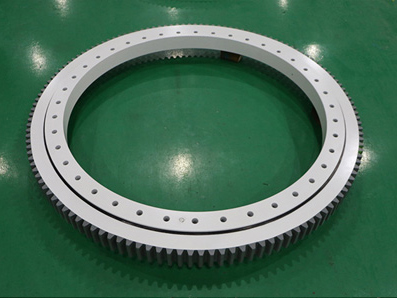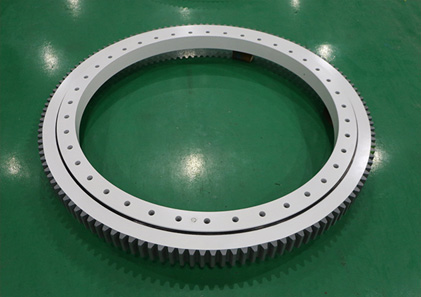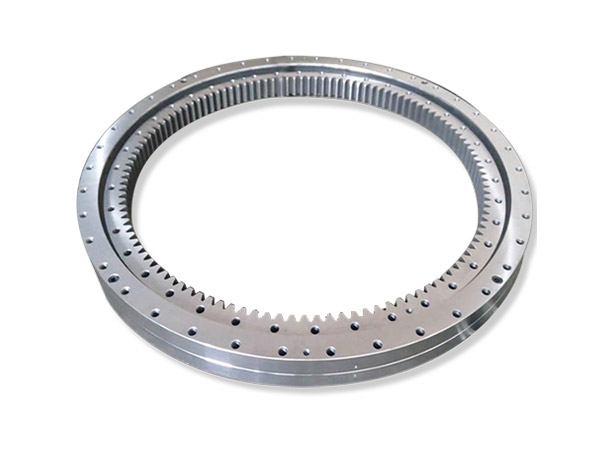El inventario de la falla de daños por cojinetes de giro común causa análisis y soluciones
Es común que los rodamientos fallen durante el funcionamiento, por lo que no hay necesidad de hacer un escándalo. En el caso de una falla, la clave para determinar la causa del daño y manejarla Hoy, el editor ha contado algunos análisis y soluciones comunes de fallas de daños en los rodamientos giratorios .
Defectos de grietas
Fenómeno de problema: parcialmente mellado y agrietado
1. La causa del fallo
① Carga de impacto excesiva; ② Interferencia excesiva; ③ Gran descamación; ④ Grietas por fricción; ⑤Pobre precisión del lado de instalación (esquina redonda demasiado grande); ⑥ Mal uso (se usa un martillo de cobre para insertar objetos extraños grandes).
2. Soluciones
①Check the conditions of use; ②Set appropriate interference and check materials; ③Improve installation and use methods; ④Prevent friction cracks (check lubricant); ⑤Check the design around the bearing.
Rotation of slewing bearing is not flexible
Trouble phenomenon: bearing heating, jitter, stuck.
1. The cause of the failure
①The clearance is too small (including the clearance of the deformed part); ②Insufficient lubrication or improper lubricant; ③Excessive load (excessive preload); ④The roller is skewed.

2. Solutions
①Set proper clearance (increase the clearance); ②Check the type of lubricant to ensure the amount of injection; ③Check the conditions of use; ④Prevent positioning errors; ⑤Check the design around the bearing (including heating of the bearing).
The hardness layer falls off
Trouble phenomenon: the running surface is peeled off, and it is obviously convex and concave after peeling off.
1. Reason
①Improper use due to excessive load; ②Poor installation; ③Poor precision of shaft or bearing box; ④Too small clearance; ⑤Intrusion of foreign matter; ⑥rusting; ⑦Hardness reduction caused by abnormal high temperature
2. Solutions
①Re-study the operating conditions; ②Re-select the bearing; ③Reconsider the clearance; ④Check the machining accuracy of the shaft and the bearing housing; ⑤Research the design around the bearing; ⑥Check the installation method; ⑦Check the lubricant and lubrication method.

Scratches and jams
Trouble phenomenon: rough surface, accompanied by micro-dissolving; scratches between ring ribs and roller end faces are called jams
1. Reason
① Poor lubrication; ② Foreign matter intrusion; ③ Roller deflection caused by bearing tilt; ④ Oil breaking on rib surface caused by large axial load; ④ Surface roughness; ⑤ Large rolling element sliding.
2. Solutions
①Re-study lubricants and lubrication methods; ②Check the conditions of use; ③Set appropriate preload; ④Strengthen the sealing performance; ⑤Use the bearing normally.
The cage is damaged
Trouble phenomenon: loose or broken rivet, broken cage.
1. Reason
①Excessive torque load; ②High-speed rotation or frequent speed changes; ③Poor lubrication; ④Entrapped foreign objects; ⑤Large vibration; ⑥Poor installation (installation in tilted state); ⑦Abnormal temperature rise (resin cage).
2. Solutions
①Check the operating conditions; ②Check the lubrication conditions; ③Re-study the selection of the cage; ④Pay attention to the use of bearings; ⑤Study the rigidity of the shaft and the bearing box.
Rusty corrosion on the surface of the slewing bearing
Trouble phenomenon: Part or all of the surface is rusty, and it is rusty in the form of pitch of rolling elements.
1. Reason
①Poor storage condition; ②Improper packaging; ③Insufficient rust inhibitor; ④Intrusion of moisture, acid solution, etc.; ⑤Hold the bearing directly by hand.
2. Solutions
①Prevent rust during storage; ②Strengthen the sealing performance; ③Check the lubricating oil regularly; ④Pay attention to the use of bearings.
Abrasion
Trouble phenomenon: red rust-colored wear particles are produced on the mating surface.
1. Reason
①Insufficient interference; ②Small bearing swing angle; ③Insufficient lubrication (or in a non-lubricated state); ④Unstable load; ⑤Vibration during transportation.
2. Solutions
①Check the interference and lubricant coating status; ②The inner and outer rings are packaged separately during transportation, and pre-pressure is applied if they cannot be separated; ③Reselect the lubricant; ④Reselect the bearing.

Wear
Phenomenon: Surface wear, resulting in dimensional changes, often accompanied by abrasion and wear marks
1. Reason
①The lubricant is mixed with foreign matter; ②The lubrication is poor; ③The roller is skewed.
2. Solutions
①Check lubricant and lubrication method; ②Strengthen sealing performance; ③Prevent positioning error.
Indentation bruises
Trouble phenomenon: surface pits caused by stuck solid foreign objects or impact and scratches caused by installation
1. Reason
①Intrusion of solid foreign matter; ②Insert the peeling sheet; ③Shock and fall off caused by poor installation; ④Install in an inclined state.
2. Solutions
①Improve the installation and use methods; ②Prevent foreign matter from entering; ③If it is caused by metal sheets, check other parts.
Electric erosion
Resolve the phenomenon: the rolling surface has a pit-like pit, and the further development is in a wave plate shape.
1. Reason
The rolling surface is energized.
2. Solutions
Make a current bypass valve; take insulation measures to prevent current from passing through the inside of the bearing.
Lo anterior es la explicación del fenómeno común de falla por daño del cojinete giratorio, el análisis de la razón y las medidas de solución. Espero que todos sean de ayuda después de leerlo. El análisis de las formas de daño y falla del rodamiento giratorio puede proporcionar una referencia detallada para el diseño y la selección del rodamiento, y luego mejorar el diseño, seleccionar racionalmente el rodamiento, dar pleno juego a la función del rodamiento, aumentar los beneficios económicos y aumentar la vida útil.


